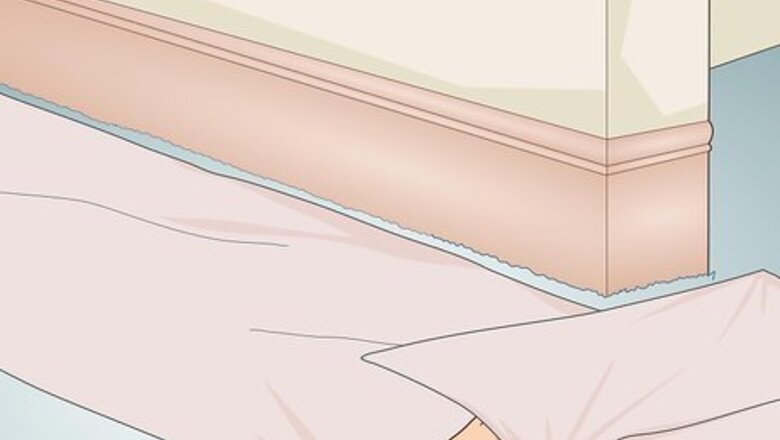
views
- You’ll need a drop cloth and painter’s tape to keep paint off of your carpet and wall.
- Tuck the carpet underneath the bottom of the trim using a putty knife.
- If you’re really worried about getting paint on your carpet, use a painter’s tray or a metal sheet to manually guide your brush.
Preparing Your Baseboards for Painting
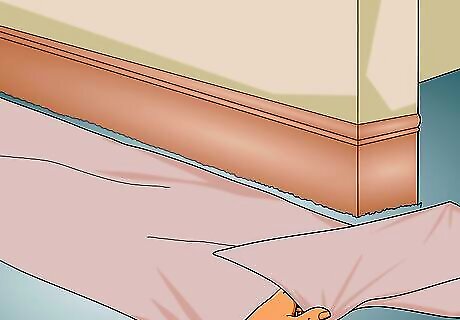
Lay a drop cloth down along the wall you’re painting. You can use a plastic or cloth drop cloth. Lay it down along the wall where your carpet meets the baseboard. This will prevent any paint or wood dust from ruining your carpet. If you don’t have a drop cloth, any non-porous material will work. Trash bags can work in a pinch! If you’re working in a larger room, move your drop cloth around the room as you paint.
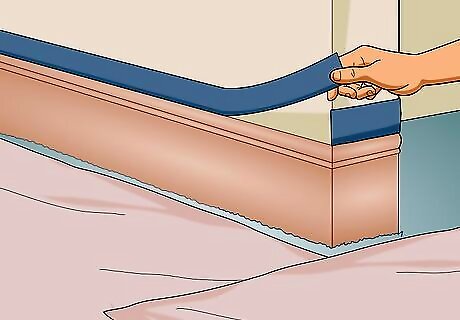
Mask off the bottom of your wall with painter’s tape. Lay the tape along the bottom of your wall to cover the drywall directly above the baseboard. Pull the tape out 2–3 feet (0.61–0.91 m) at a time and gently press it against the wall so that it’s flush with the drywall. Painter’s tape isn’t always perfect and paint can bleed through it on occasion. Use it as a guide, not a perfect safety measure, and try to avoid hitting it with your brush when you paint. Repeat this process until every wall in your room is taped off.
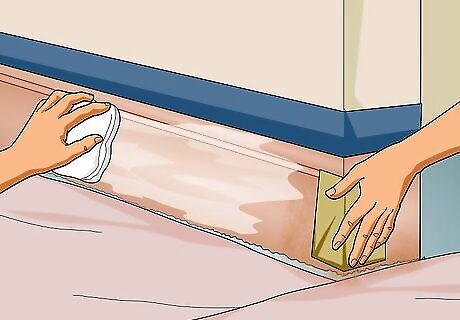
Clean your baseboards and sand them down if necessary. Take a damp cloth and wipe your baseboards and remove any dust that might get trapped in your paint. Let the boards air dry. Use 100-180 grit sandpaper to sand the wood and make painting easier. Take a small sheet of sandpaper and rub it gently along a section of baseboard by using back-and-forth strokes until you see the previous layer of paint smoothing into the wood. Wipe your boards with a dry cloth after sanding. If your baseboards are brand new or haven’t been painted multiple times in the past, you don’t need to sand them down. Be careful when sanding the upper and lower sections of your baseboard near the wall and carpet. You don’t want to scuff the walls while you work. Let your baseboards air dry for at least an hour before you paint them. You don’t want to capture any moisture in the wood. Wear a dust mask when sanding your baseboards to prevent the inhalation of wood dust.
Masking the Carpet Off
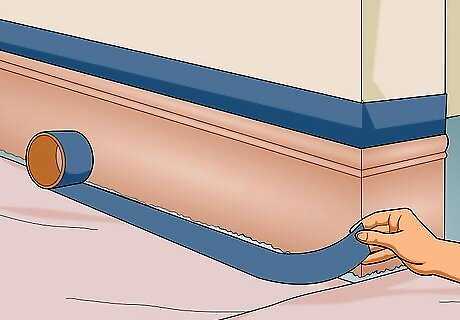
Lay painter’s tape over the drop cloth where it meets the baseboard. Pull out a section of tape that’s roughly 2–3 feet (0.61–0.91 m) long and place it gently with the sticky side down over your carpet and drop cloth where it meets the baseboard. Don’t press down. You can use packing or masking tape instead of painter’s tape if you’d like. Duct tape will rip up your carpet, so avoid that stuff. Alternatively, you can try gently tugging on the carpet to see if it comes up. If it does come up, you can roll the edge of the carpet under itself to create a gap for your paint brush.
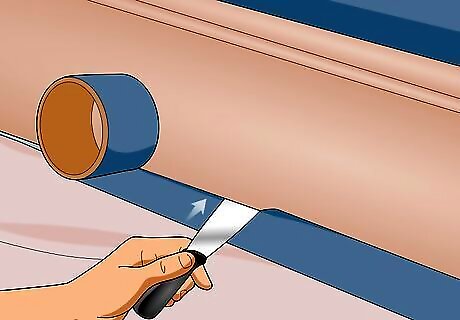
Tuck the tape under the trim with a putty knife. Stick your knife at a 15-degree angle to the floor and place it in between the board and the carpet. Press gently into the wall to pull the tape that was resting on the bottom of the baseboard underneath it. Run your putty knife in between the carpet and the wall for every section of the room. Press your tape down lightly when you’re done. The ⁄2 inch (1.3 cm) of tape that was sitting on the bottom of your baseboard should now be tucked underneath your baseboard. This will prevent drips from sneaking under the tape and damaging your carpet.
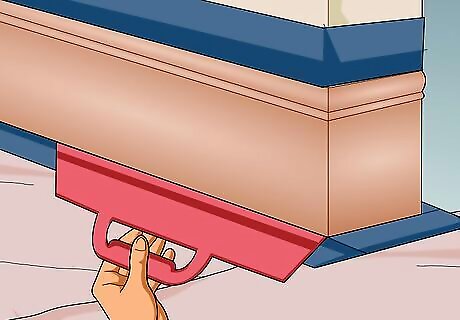
Use a paint guard if you want extra protection. You can use a trim paint guard or a metal sheet to provide additional protection as you paint. To use a paint guard, put the long edge on top of the tape where it meets the baseboard. Press it down into your carpet and slide it under your baseboard to 100% cover your carpet. You can use a metal sheet or any firm straight edge instead of a paint guard if you’d like. One alternative is to use a slat from a window blind with the round side facing up. If you use a paint guard, clean it with a rag after painting each section.
Applying the Paint
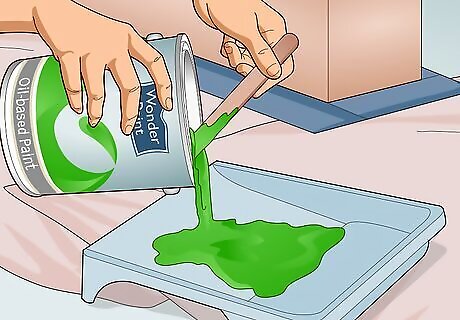
Mix your paint with a mixing stick and pour it into your paint tray. While standing on your drop cloth, use a flathead screwdriver to carefully pry your can open. Use a mixing stick to mix your paint until the color is even and uniform. Pour ⁄4–⁄2 gallon (0.95–1.89 L) into your paint tray and use your brush to wipe away any drips running along the side of your can. Most people use semi-gloss paint for baseboards and trim. You can use oil-based or latex paint depending on the sheen that want. Oil-based paint will last for a longer period of time, but it will reflect light more brightly. Open the windows in the room that you’re painting to prevent the paint fumes from overwhelming you.
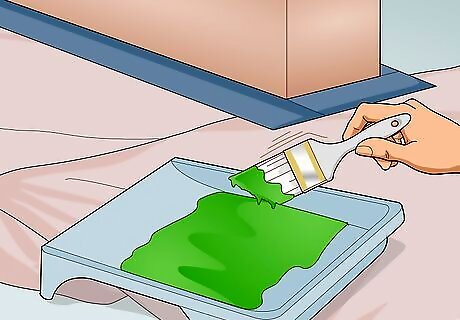
Dip an angle brush in the paint and tap it in the tray. A 2–3 in (5.1–7.6 cm) brush is ideal for baseboards. Dip the tip of your brush into the paint so that the tip of your brush is covered in paint. Tap the brush into the dry section of your paint tray to remove excess paint. You can use a flat brush if you prefer, but an angle brush will make it easier to reach the very bottom of your baseboard, since you can get a flat cut by holding it at 45 degrees. Feel free use a nylon or natural brush—both will work well for baseboards.
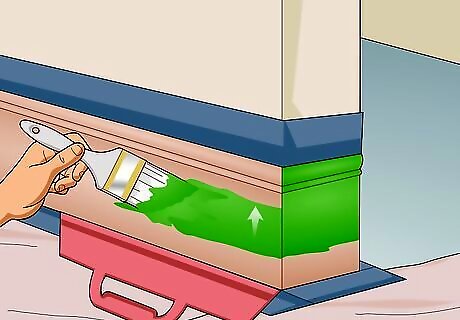
Start with the middle of the baseboard, then paint the top. Use back-and-forth strokes to apply your paint. Cover each section of baseboard 2-3 times. Once the majority of the paint on your brush has been applied, paint the portion directly above it near the tape on the drywall. Hold your brush at a 45-degree angle and only brush the top in the direction of the brush’s angle to monitor the accuracy of your cut. Work slowly when painting along the edge, and work in 1 foot (30 cm) increments.
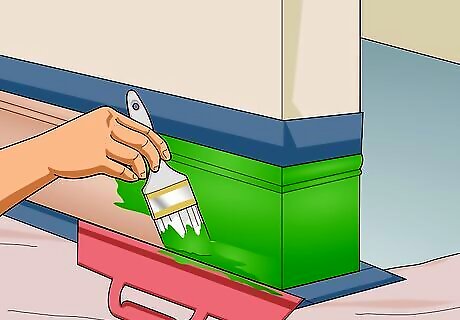
Paint the bottom of your baseboard carefully and slowly. Once you’ve painted the top and middle of your board, dip your brush into the paint tray and tap it repeatedly to remove most of the paint. Then, tilt your brush so that it’s at a 45-degree angle with the long end facing the carpet. Press your brush into the board and move very slowly and carefully along the bottom of the baseboard. If you’re using a paint guard, hold it in place with your nondominant hand. Only brush along the section where you’re holding the paint guard. To remove and reset a paint guard, press it down into the carpet and slowly slide it out. Wipe it clean, move it to a different section of your baseboard, and slide it between the baseboard and carpet.
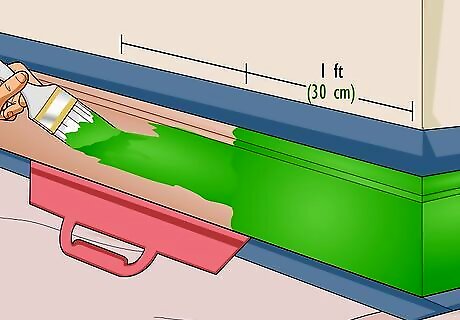
Work your way around the room in 1 foot (30 cm) increments. If you’re using a paint guard, bring it with you as you work. Move your drop cloth with you as you paint so that it’s always underneath the section that you’re painting. Always work from the middle to the top before painting the bottom. Avoid drips by covering each section in the middle of your baseboards 2-3 times before moving on.
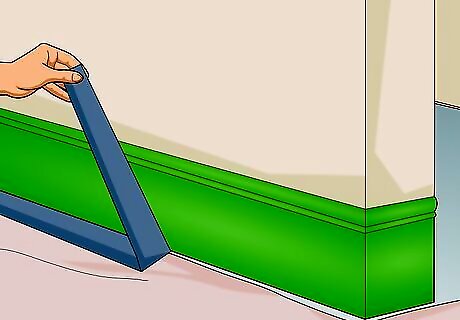
Remove the tape carefully after your paint has dried. Once you’ve let your baseboards dry for 2-3 hours, remove the drop cloth and other painting materials. Pull the long side of the masking tape up a little and slide it out from under your baseboard. Slowly pull it out in sections to avoid rubbing any dry paint on your carpet.


















Comments
0 comment